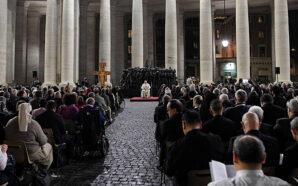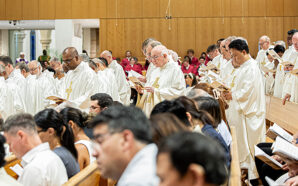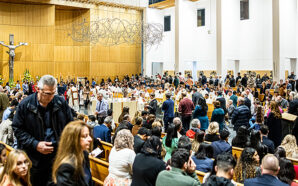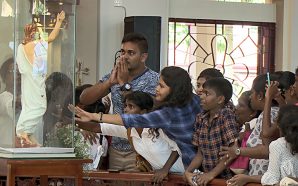Second Sunday of Advent
Readings: Isaiah 40:1-5, 9-11; Psalm 84(85):9-14; 2 Peter 3:8-14; Mark 1:1-8
10 December 2023
“Prepare a way for the Lord.” – Mark 1:2
Isaiah reminded the Chosen People that they would be liberated from their Babylonian exile to the Promised Land. John the Baptist, echoing Isaiah, reminds the people that the Messiah will liberate them from their slavery to sin to the freedom of the children of God. The Church echoes John in today’s second reading, reminding the new People of God, as Peter did, “[To live] holy and saintly lives as you wait for the Day of God to come” (2 Pt 3:11–12) in hope.
We must seriously heed St Peter’s advice and strive to live holy and saintly lives so that God will find us at peace and ready for him whenever that day does come for each of us. But how can we do this in today’s post-Christian society that largely has not only become spiritually deaf to the voice of the Church, but often actively opposes and works against it and the Christian message of the Gospel?
Only prayer, sacrifice, and graced personal holiness of life can straighten what has become twisted and buried in the moral and human turmoil of the lives of so many today. This will only happen when Christ is born again in the hearts of individual believers and families, who like leaven, can transform the world once more in the image and likeness of God, as happened when Christ was first born. And for this to happen, we must maintain a serious, daily prayer life that includes reading and meditating on the sacred Scriptures, regular Confession and worship at Mass, and a solid devotion to Our Lady. These fundamentals are the Christian’s road map of life; without them we will very quickly lose our hope and our way.
Mary, Mother of the Word made flesh, pray for us. St Joseph, Guardian of the Redeemer, intercede for us. Amen.
Fr Christopher G Sarkis
Artist Spotlight
Burial of Saint Lucy – Michelangelo Merisi da Caravaggio (1571 – 1610)
Burial of Saint Lucy (c. 1608). Oil on canvas, 408cm x 300cm. Santa Lucia al Sepolcro, Syracuse, Sicily, Italy. Public Domain.
St Lucy’s feast falling during Advent (13 December 2023) is entirely appropriate. Her very name means “light”, and Advent is the feast of Light, symbolised by the growing popularity of the Advent wreath. As Christmas draws near, the light becomes brighter week by week.
Lucy died in the year 304 at Syracuse in Sicily during the persecution of the emperor Diocletian. Devotion to the saint was so widespread, her name was included in the Canon of the Mass—a great privilege.
According to tradition, Lucy’s family was of noble lineage and were wealthy landowners. Lucy’s father died when she was only five. She is said to have been very beautiful, and her mother was planning a happy marriage. Lucy had other ideas—she had already given her heart to Christ.
For 40 years, Lucy’s mother had suffered from serious haemorrhages for which no remedy had been found. Lucy suggested her mother should touch the tomb of St Agatha at nearby Catania, just as the woman in the Gospel with the same complaint had touched the robe of Jesus. But during a dream, Lucy had a vision of St Agatha, who said to her: “Why do you ask me something that you yourself can accomplish? In fact, your faith has helped your mother, and see, she has been cured.” In thanksgiving, Lucy’s mother acceded to her daughter’s request that she give her dowry to the poor and live for Christ alone. Such an act of charity caused amazement among the pagan population, in particular her intended suitor, who promptly denounced her to the authorities.
At this moment, the emperor Diocletian initiated his most ferocious persecution. Lucy was ordered to sacrifice to the Roman gods. She replied, “Pure sacrifice to God is to visit widows, orphans and pilgrims who are in need of help, and it is already three years since I offered to Jesus Christ such sacrifices by distributing all my worldly wealth.” When various tortures could not move her, the prefect, suspecting her of witchcraft, ordered Lucy to be burned to death. The fire would not touch her, and she was finally decapitated, but not before addressing the assembled crowd, predicting that the persecution of the Church was soon to end. According to tradition, the execution took place on 13 December 304. (Nine years later, the emperor Constantine declared Christianity the religion of the empire.)
Tradition makes her patron of the blind. Legends abound that, during her passion, her eyes were torn out and then miraculously restored by St Raphael. Her earliest image still survives in the procession of virgins in the sixth century mosaics in Sant’Apollinare Nuovo in Ravenna. Dante’s son relates that, in gratitude for the recovery of grave damage to his sight through the intercession of St Lucy, his father placed her name in Canto II of The Inferno, Canto IX of Il Purgatorio, and in Canto XXXIII of Il Paradiso.
The poor girl was not to rest in peace. In 1040, the Greeks succeeded in wrestling Syracuse from the Arabs, and Lucy’s body was sent to Constantinople. There, it rested until 1204 when the city fell to Venice. It was then placed in the Basilica of San Giorgio Maggiore—an islet opposite St Mark’s. Pilgrimages abounded until a tragedy in 1279, when several pilgrims drowned when their boat capsized. The body was moved to a church on the mainland. But in 1860, Venetian authorities decided to enlarge the railway station, and Lucy’s relics were transferred to the nearby parish church. The railway station has ever since been known as Santa Lucia.
The story does not end there. On the morning of 8 November 1981, Venice awoke to the shocking news that on the evening before, St Lucy’s body (it has never corrupted) was removed from its casket—the thieves leaving the head in its silver mask. In what was regarded as a miracle, the body was recovered the following month on the very eve of her feast, and brought back to the church in a great procession of boats along the Grand Canal.
May St Lucy restore our sight so that we may clearly see the great truths Christ has revealed to us! And may the gift of her dowry to the poor encourage us to be generous to the various Christmas appeals. That our gift cannot be returned makes it all the more precious.
Michelangelo Merisi da Caravaggio, known to us as Caravaggio, was an Italian painter born in Milan in 1571. His work triggered the beginning of the Baroque period. He lived a short and tempestuous life, and while his paintings were popular, they were considered controversial. In 1608, he escaped from prison in Malta, held on an unknown charge. He found sanctuary in the Church of Santa Lucia al Sepolcro in the Sicilian city of Syracuse. There, he was commissioned to paint the Burial of Saint Lucy—the city’s patron.
Previous artists had exploited the gruesome details of Lucy’s martyrdom. Caravaggio focused rather on the tragedy of the event, seen in the strong emotions of the gathered crowd. The gravediggers who might easily dominate the picture by taking up the foreground, seem to frame Lucy instead. A guard stands off to the right, reminding the viewer of how and why Lucy died. The whole scene takes us back to the age of the Church of the Catacombs. This was one of Caravaggio’s last works, painted just two years before he died. It is at the moment being restored.
Monsignor Graham Schmitzer
Fr Christopher G Sarkis is the parish priest of Our Lady Help of Christians Parish in Rosemeadow, in the Diocese of Wollongong, NSW. He was ordained in 1985 and has served in a number of parishes in the diocese. His current diocesan appointments include the College of Consultors, Council of Priests, and Clergy Remuneration Fund.
Monsignor Graham Schmitzer is the retired parish priest of Immaculate Conception Parish in Unanderra, NSW. He was ordained in 1969 and has served in many parishes in the Diocese of Wollongong. He was also chancellor and secretary to Bishop William Murray for 13 years. He grew up in Port Macquarie and was educated by the Sisters of St Joseph of Lochinvar. For two years he worked for the Department of Attorney General and Justice before entering St Columba’s College, Springwood, in 1962. Mgr Graham loves travelling and has visited many of the major art galleries in Europe.
With thanks to the Diocese of Wollongong, who have supplied this reflection from their publication, The Sign: Advent and Christmas Reflections 2023. Reproduced with permission.








